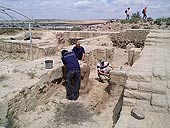Conservation studies in Israel have made considerable advances in recent years. Today, there are academic courses of study in the field of heritage conservation, and a variety of courses, short continuing education courses, study days, field trips and informal training in conservation. Yet, the last practical training course was held in 1995 by the Israel Antiquities Authority, and the need for a professional practical training program for conservationists became imperative.
The Conservation Course. The practical conservation course constitutes the core of the training program. It is held in the International Conservation Center, Citta di Roma, in Old ‘Akko and at several other sites. Workshops are held at Yehiam Fortress, Bet She'an, Caesarea, Tel Aviv, Migdal Tzedek and Mamshit. The course consists of 24 one-day sessions conducted over a five month period. The participants receive a total of 192 hours of training in heritage preservation.
Conservators from the Israel Antiquities Authority, the Nature and Parks Authority and the private sector were among the participants in the courses. Admission requirements to the course include an interview with a professional admissions committee made up of representatives from the partner organizations, academics and representatives from the private sector. The minimum requirements for admission were practical work experience of four years and work in the field. Course participants are required to submit exercises, and upon conclusion of the course must hand in a final work that is the project the conservator carried out. These assignments are a prerequisite for receiving a conservator’s certificate which is recognized by the program’s partner organizations.
List of Recognized Conservators. The partner organizations have taken it upon themselves to promote recognition of the profession of built-heritage conservator and institutionalize it. Thus, with the inauguration of the program, they stand committed to employ only those conservators that have recognized certification, issued by the training program operated on their behalf.
As of the summer of 2015, seventy-three individuals are recorded on the list of conservators recognized by the organizations that are partners in the training program. Thirty-four of the conservators have more than twenty years of experience in the field (the so-called “generation of the wilderness”) and thirty-nine are graduates of the first and second classes of the practical training program. The list is published on the partners’ websites.













